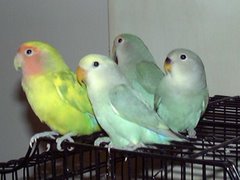Sexing Budgies: Herculean Task?
Nowadays most of the lovebirds owners switch over to raising budgies as it is cheap to procure. But they have ended in sorrow due to the fact that they're unable to sex them.
The simple method for sexing Budgies is looking cere (the bit above it's beak). In male, it will be blue in color and in females they will be white cere with a hint of blue. It is very easy to differentiate adult and male. But the young ones are very difficult to differentiate. In young male, purple-pinkish colour cere is present and in females, they will have will have a pale blue cere with white rings around the nostrils.
See the picutres below and then you can sex the budgies very easily...
Male Adult Budgerigar
Female Budgerigar









 Free Ads For Bloggers
Free Ads For Bloggers

